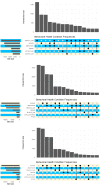Mental health and substance use disorder comorbidities among Medicaid beneficiaries: Associations with opioid use disorder and prescription opioid misuse
- PMID: 37842281
- PMCID: PMC10567978
- DOI: 10.3934/publichealth.2023046
Mental health and substance use disorder comorbidities among Medicaid beneficiaries: Associations with opioid use disorder and prescription opioid misuse
Abstract
Background: Medicaid presently insures about one-fourth of the US population and disproportionately insures about 38 % of non-elderly adults with an opioid use disorder (OUD). Owing to Medicaid's prominent role insuring persons with an OUD and that Medicaid coverage includes pharmaceutical benefits, there has been considerable interest in studying potential prescription opioid misuse among Medicaid beneficiaries and identifying subpopulations at higher risk for misuse and possible progression to an OUD.
Methods: The study goals were to explore the associations among prescription opioid misuse, OUD, and co-occurring mental health and other substance use disorders (SUD). We analyzed Illinois Medicaid 2018 claims data for 1102479 adult beneficiaries 18 to 64 years of age. Using algorithms based on previous studies, we first determined either the presence or absence of nine SUDS (including OUD), nine mental health disorders and likely prescription opioid misuse. Then, we subdivided the beneficiary sample into five groups: those who were prescribed opioids and evidenced either no, possible, or probable misuse; those evidencing an OUD; and those evidencing no opioid use or misuse.
Results: Bivariate analyses, upset plots, and multinomial logistic regressions were used to compare the five subgroups on the prevalence of co-occurring SUDS and mental health disorders. Those with an OUD or with probable prescription opioid misuse had the highest prevalence of most co-occurring conditions with beneficiaries with an OUD the most likely to evidence co-occurring SUDS, particularly tobacco use disorder, whereas those with probable misuse had elevated prevalence rates of co-occurring mental health disorders comparable to those with an OUD.
Conclusion: The medical complexity of persons with an OUD or misusing prescription opioids are considered in light of recent attempts to expand buprenorphine provision as a medication for OUD among Medicaid beneficiaries. Additionally, we consider the possibility of gender, co-occurring mental health disorders, and tobacco use disorder as important risk factors for progressing to prescription opioid misuse and an OUD.
Keywords: Medicaid; behavioral health comorbidities; co-occurring mental health disorders; co-occurring substance use disorders; medical complexity; opioid use disorder; prescription opioid misuse.
© 2023 the Author(s), licensee AIMS Press.
Conflict of interest statement
Conflict of interest: There is no conflict of interest in this study.
Figures

Similar articles
-
Association of polysubstance use disorder with treatment quality among Medicaid beneficiaries with opioid use disorder.J Subst Abuse Treat. 2023 Jan;144:108921. doi: 10.1016/j.jsat.2022.108921. Epub 2022 Oct 27. J Subst Abuse Treat. 2023. PMID: 36327615 Free PMC article.
-
Adverse events among adult Medicaid enrollees with opioid use disorder and co-occurring substance use disorders.Drug Alcohol Depend. 2021 Apr 1;221:108555. doi: 10.1016/j.drugalcdep.2021.108555. Epub 2021 Jan 29. Drug Alcohol Depend. 2021. PMID: 33596496
-
Trends in and Characteristics of Buprenorphine Misuse Among Adults in the US.JAMA Netw Open. 2021 Oct 1;4(10):e2129409. doi: 10.1001/jamanetworkopen.2021.29409. JAMA Netw Open. 2021. PMID: 34652446 Free PMC article.
-
Facing Addiction in America: The Surgeon General’s Spotlight on Opioids [Internet].Washington (DC): US Department of Health and Human Services; 2018 Sep. Washington (DC): US Department of Health and Human Services; 2018 Sep. PMID: 30860690 Free Books & Documents. Review.
-
Medication Prescribing and Behavioral Treatment for Substance Use Disorders In Physician Office Settings.2015 Nov 4. In: The CBHSQ Report. Rockville (MD): Substance Abuse and Mental Health Services Administration (US); 2013–. 2015 Nov 4. In: The CBHSQ Report. Rockville (MD): Substance Abuse and Mental Health Services Administration (US); 2013–. PMID: 27030870 Free Books & Documents. Review.
References
-
- Center for Medicaid and CHIP Services. April 2022 Medicaid and CHIP enrollment trends snapshot. 2022. Available from: https://www.medicaid.gov/sites/default/files/2022-07/april-2022-medicaid....
-
- Saunders H, Rudowitz R. Demographics and health insurance coverage of nonelderly adults With mental illness and substance use disorders in 2020. Washington, DC: Kaiser Family Foundation; 2022. Available from: https://www.kff.org/medicaid/issue-brief/demographics-and-health-insuran....
-
- U.S. Department of Health and Human Services Centers for Medicare & Medicaid Services. Substance Use Disorder Prevention that Promotes Opioid Recovery and Treatment for Patients and Communities (SUPPORT) Act: Section 1003 Demonstration project to increase substance use provider capacity. U.S.: Departmemt of Health and Human Services Centers for Medicare & Medicaid Services; 2019. Available from: https://www.medicaid.gov/medicaid/benefits/behavioral-health-services/su....
LinkOut - more resources
Full Text Sources
